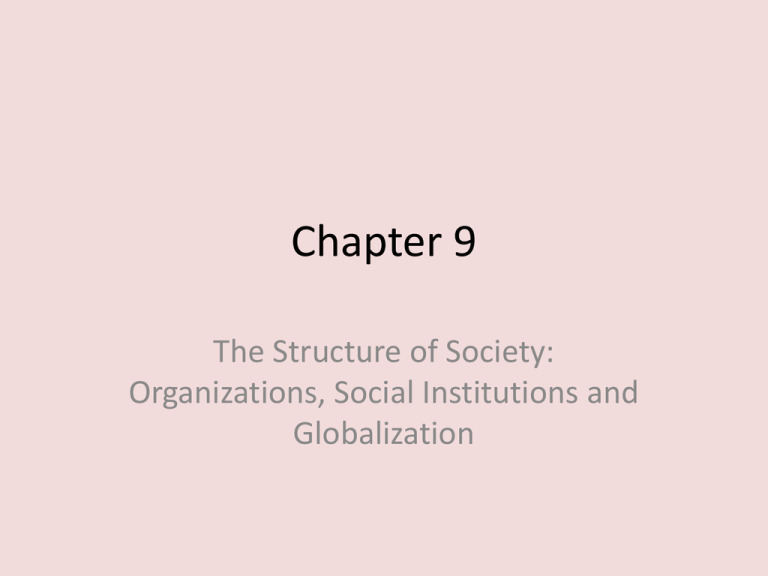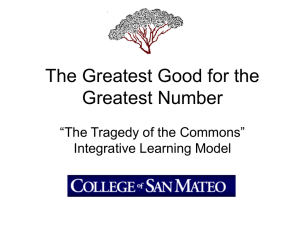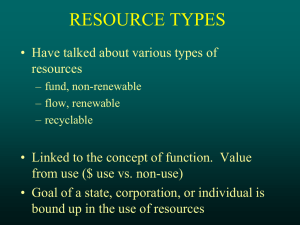Chapter 9 Notes
advertisement

Chapter 9 The Structure of Society: Organizations, Social Institutions and Globalization Social Structure • Framework of society that exists above the level of individuals – – – – – – – Social institutions Organizations Groups Statuses and roles Cultural beliefs Institutionalized norms Adds order and predictability to our private lives • Can create tension between needs of individual and needs of system Education • Education • Organizations: NEA, PTA, school board • Groups: faculty, administrators, students, clubs, classes, cafeteria staff • Statuses: teacher, student, principal, counselor, coach, librarian, custodian • or screaming in the classrooms Education • Role expectations: learning, teaching, coaching, disciplining, test taking • Cultural beliefs: education leads to financial success; education is necessary to a democratic society • Institutionalized norms: everyone must attend school until at least age 16; everyone must wear appropriate clothing; no running in the halls or screaming in the classrooms Social Structure and Catastrophe • Miners in Chile – Created a social structure underground • Tsunami in Japan – People created social structures in community centers • Tsunami in Southeast Asia – Organizations could not handle the influx of financial assistance – Indonesia could not handle the influx of aid workers Social Dilemmas • Potential for a society’s long-term ruin because of individuals’ tendency to pursue their own short-term interests The Tragedy of the Commons • Medieval towns had commons where everyone’s livestock grazed • Everyone has to share evenly for everyone to survive • If one person takes more, ultimately the whole system fails • That’s the tragedy of the commons What Causes the Tragedy of the Commons? • Lack of trust within the community • Lack of communication • People don’t believe the problem is serious • People don’t believe their “tiny” part will make a difference Free-Rider Problem • When people don’t contribute to something that they can get anyway • At the institutional level – Education: people want to limit taxes to fund public education – Public education benefits the whole society Solutions to Social Dilemmas • • • • Creating “clan” loyalties Privatization Centralization Required joining of the community Structure of Formal Organizations • Complex societies require complex organizational structures to function • Max Weber (Mahx Vaybare) • Bureaucracies – Large hierarchical organizations governed by formal rules and regulations and having a clear specification of work tasks – Necessary to complex societies – Efficient and rational Bureaucracies • Division of labor – More efficient – More goals are possible • Hierarchy of authority – In U.S. societies: pyramidal shape – Authority attached to the position, not the person Hazards of Bureaucracy • Tendency toward conformity over critical thinking and problemsolving • Can become overly dehumanizing • Lock people in McDonaldization of Society • Characteristics and principles of the fast food restaurant in other areas of social life – Streamlined processes – Uniform goods or services – Speeded up transactions McDonaldization of Society • George Ritzer: metaphor for harmful effects of bureaucratization on society – Impelled by economic interests – Efficiency has become culturally desirable – Parallels other changes in society Organizational Hierarchies and Our Jobs • Upper echelons – – – – Few in number Jobs don’t have clear boundaries Paid in salary Insulated from the rest of the organization – Similar types of people in these roles • almost 90% of chief executives in the United States are non-Hispanic whites • 76% are men • all but eight of the chief executive officers in the 500 largest American companies are men Organizational Hierarchies and Our Jobs • Middle echelons – May have conflicting role expectations – May have little true opportunity for advancement • Caught between those below—who need cooperation—and those above—who grant them authority • Morale sustained by idea of moving up • Vast majority of middle-level employees do not move up – May align very strongly with the organization Organizational Hierarchies and Our Jobs • Lower echelons – Rarely define their own occupational tasks – Work is frequently divided into small parts – De-skilling with technological advancements – Paid in hourly wages – Expected to abide by laws, work hard, be personally accountable – Paid the least, valued least, and considered expendable Characteristics of Organizations • Common language, jargon • Internalized rules, values, and beliefs • Not all rules can be taken literally—flexibility – Combination of formal structural rules and informal patterns of behavior Institutional Pressures Toward Similarity • Nature of problems use similar methods of dealing with them • Continual innovation to improve methods Interconnectedness of Organizations • Textbooks – Texas accounts for about 15% of all textbook sales • TV shows and movies – Remakes of successful older movies and shows • Globalization – Get cash anywhere in the world with your ATM card from your U.S. bank • Innovation – The first to innovate can be very successful, but the rest will imitate U.S. Health Care System • Social institution and network • Hospitals tightly linked to one another • Formal training organizations in place • Funding organizations must also be linked • Links to other organizations: – – – – Equipment Drug industry Insurance Political action groups Global Economy • Multinational Corporations – Control a significant portion of the world’s wealth – Heavily influence the tastes of people everywhere – Don’t owe their allegiance to any one country Global Economy • Social problems – Higher unemployment in countries losing manufacturing – Exploitation of workers in developing countries – Eroding ability of governments to set policies to protect national economy Global Impacts on Education • Concern over competition globally – Call for education reforms to math, science • Concern that children suffer from far too much emphasis on performance and achievement – Calls to reduce homework for elementary school Global Impacts on Religion • Two-thirds of world’s people belong to three religions – Christianity – Hinduism – Islam Global Impacts on Religion • Some denominations globalizing to deal with shrinking membership — Mormon Church grown by 500% outside of the United States and Canada since 1980 • Competing worldviews challenge traditional beliefs











